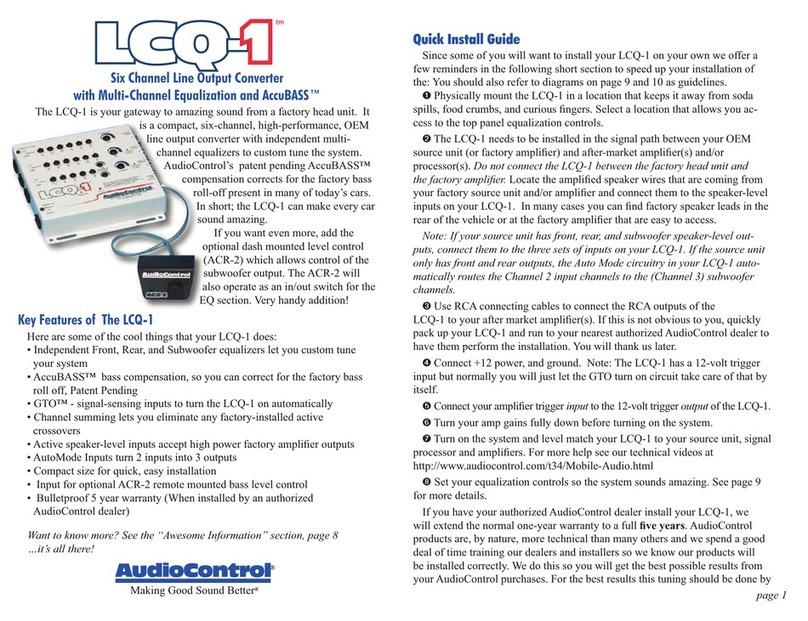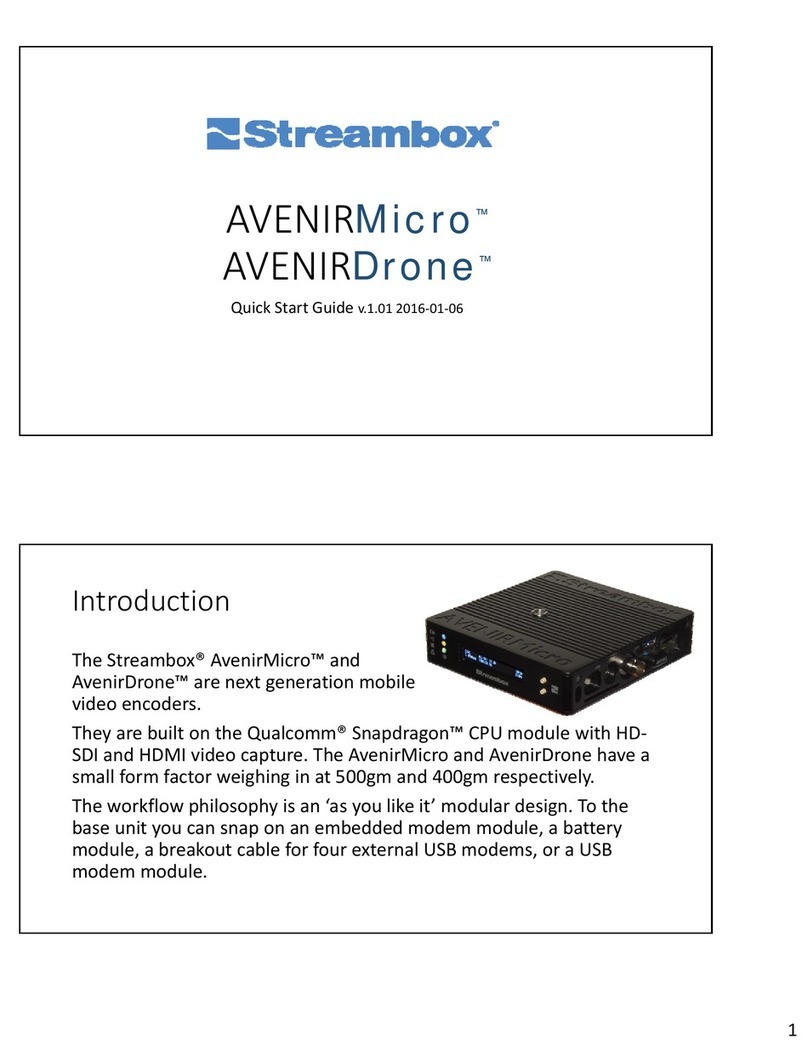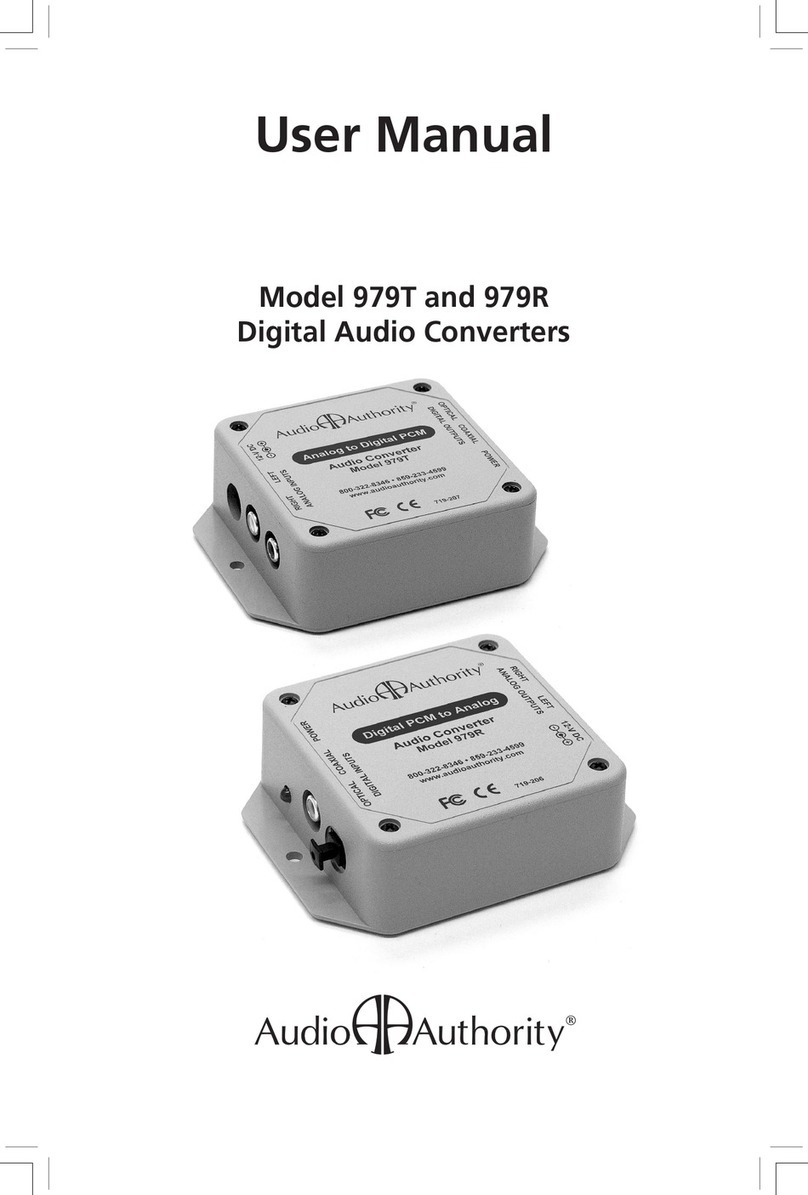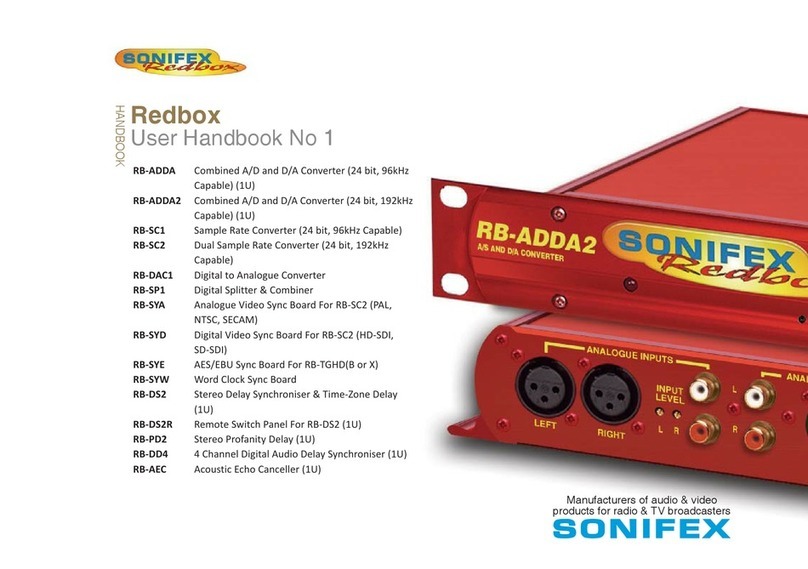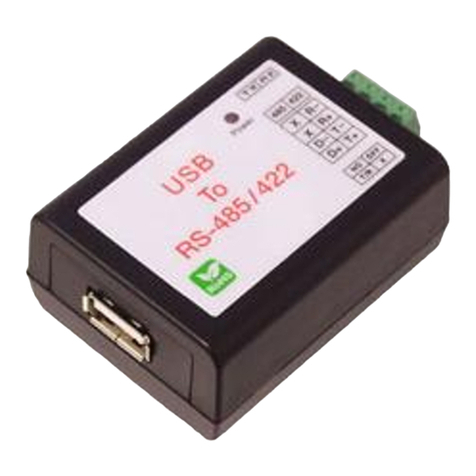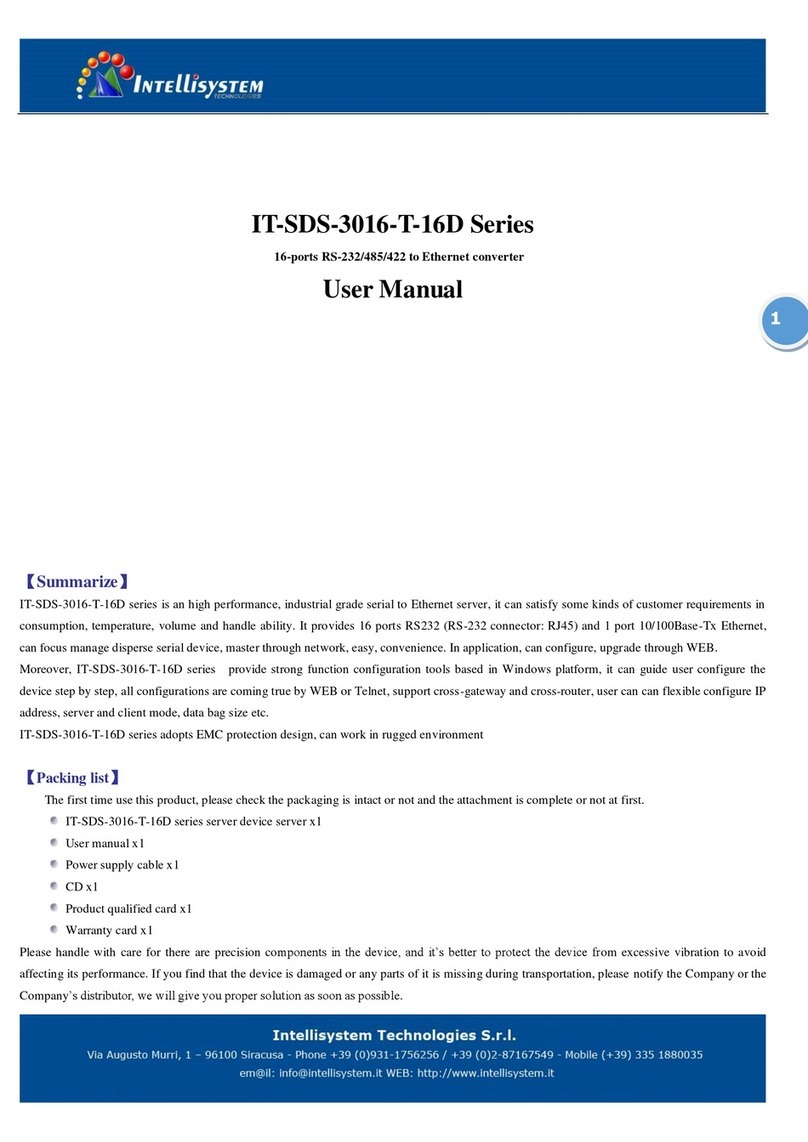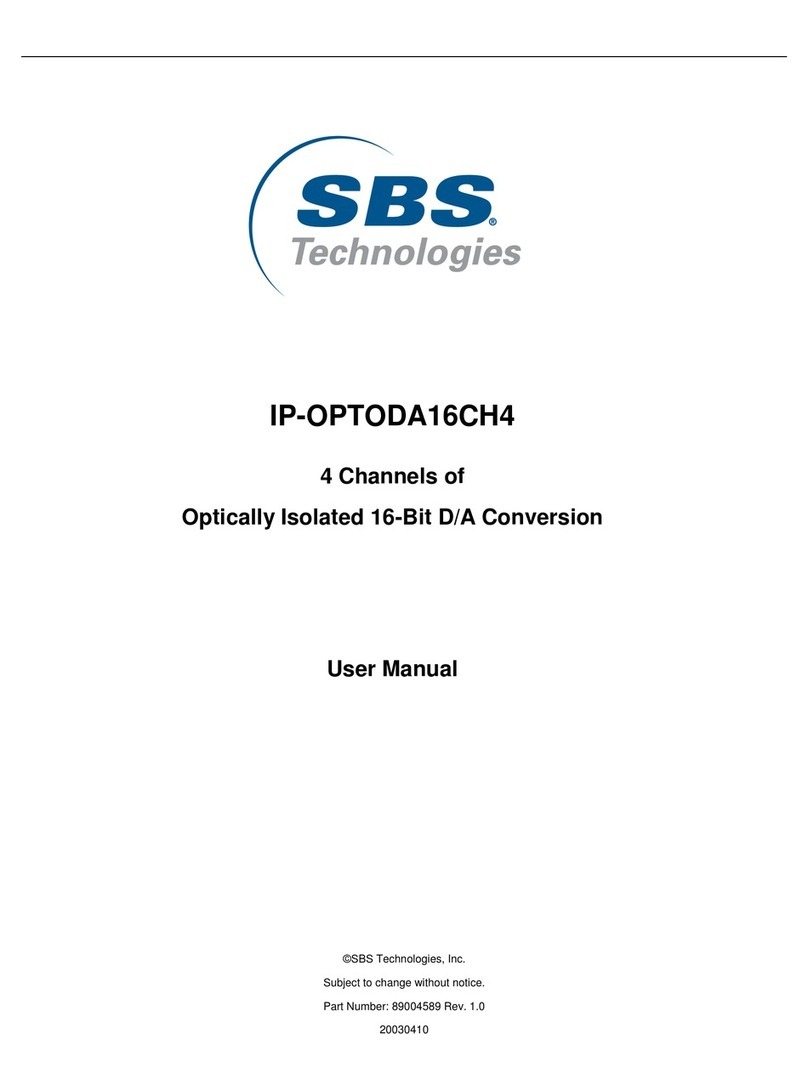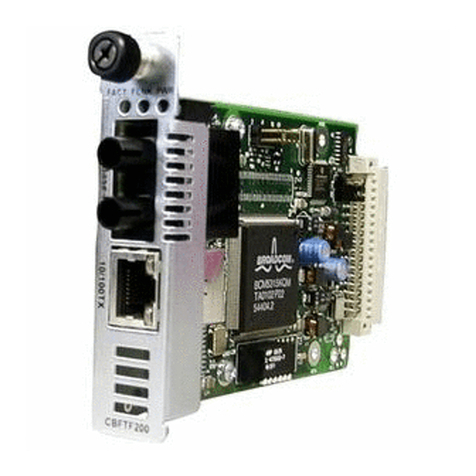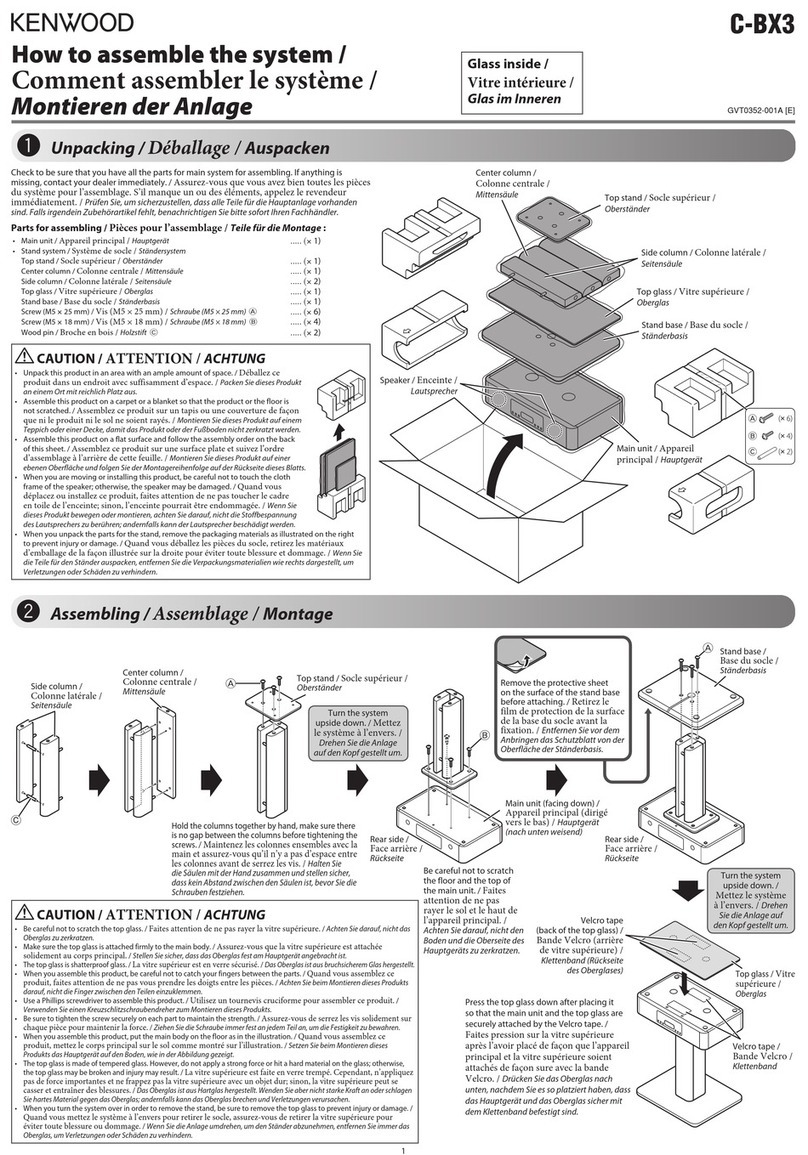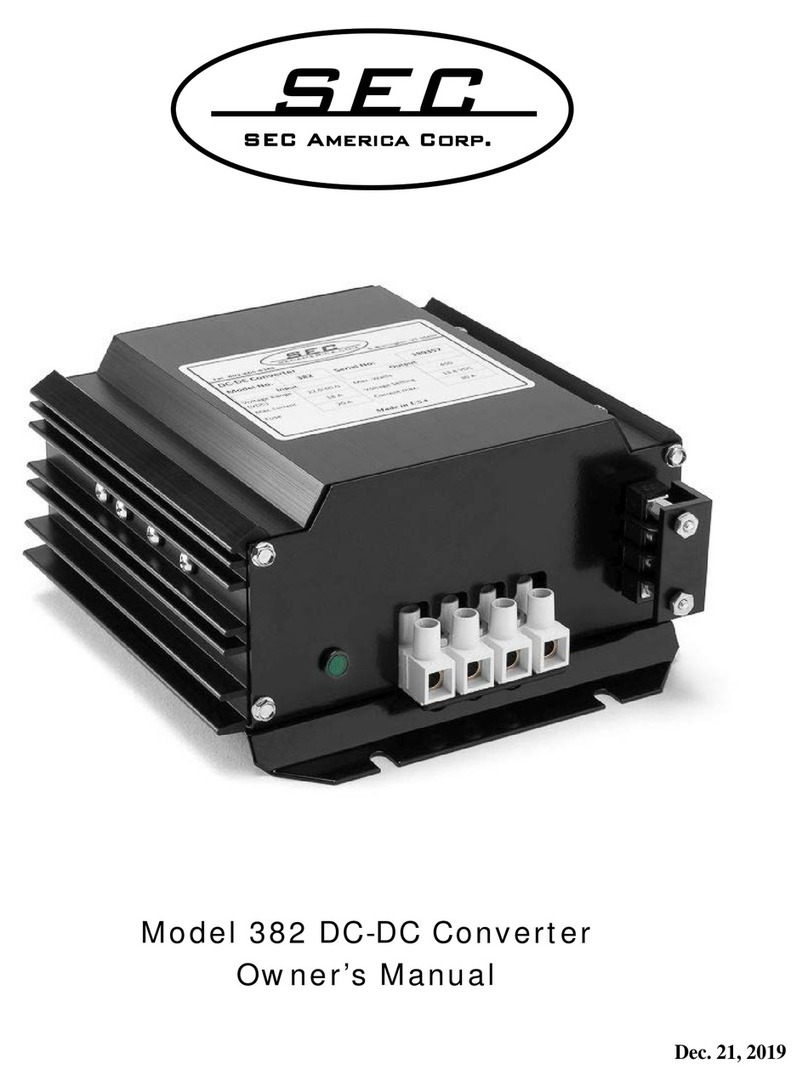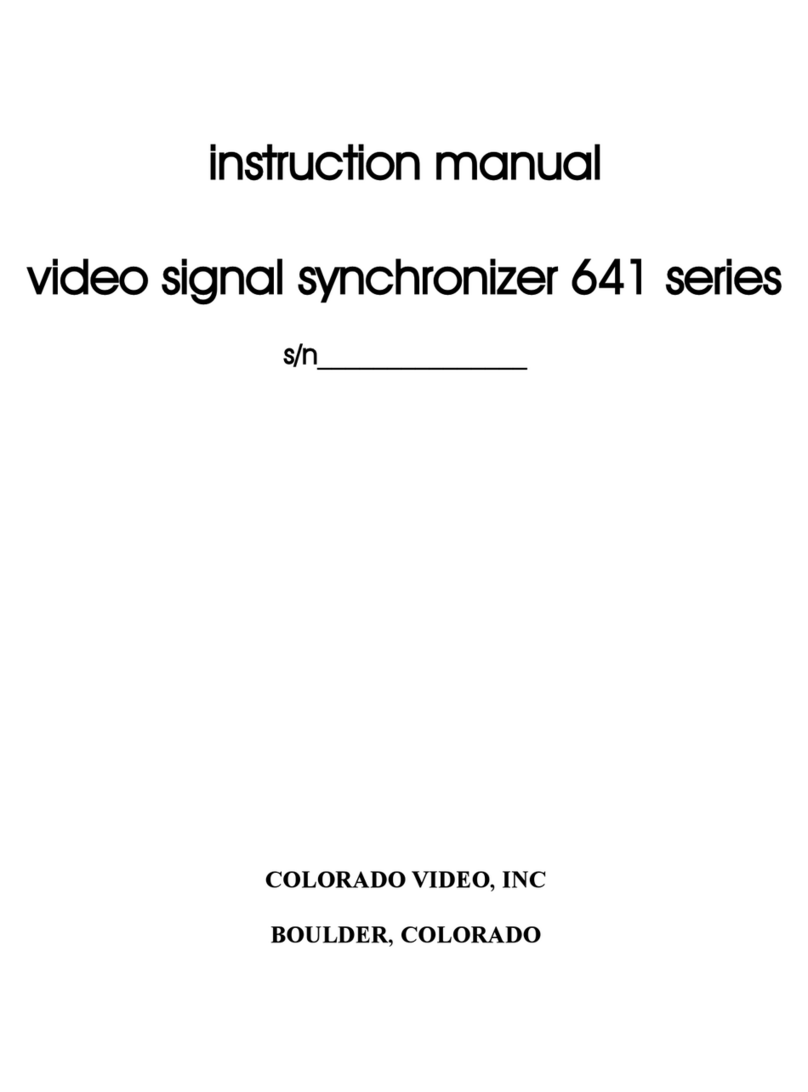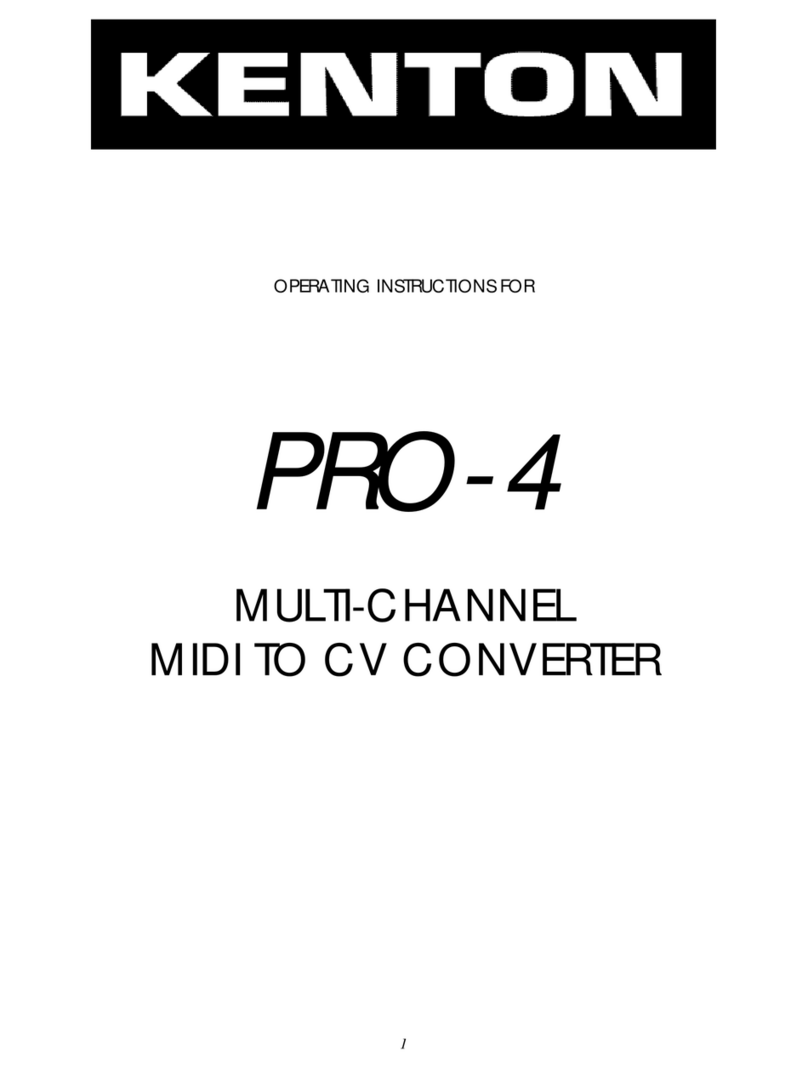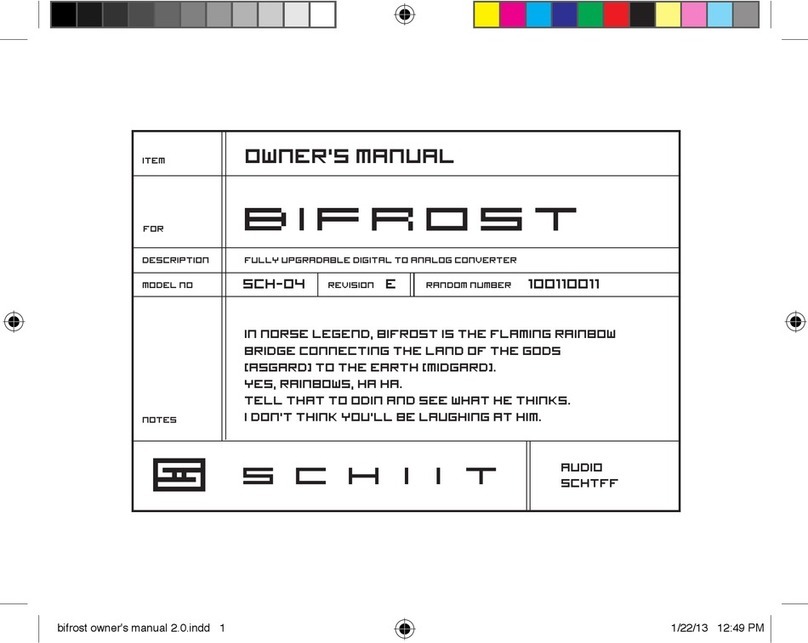Audio Control LC6 User manual

tmLC6tm
Six Channel Line Output Converter
For interfacing with factory installed audio systems
Greetings from the rainforests of the Pacific Northwest. We would
like to congratulate you on your purchase of the LC6; a six-
channel, high-performance, line-output converter. This unique
product will accept two, four, or six channels of speaker-level signal from
a factory-installed amplifier or source unit and convert it to a high-quality,
low-noise pre-amp signal. Therefore the LC6 will allow you to use your
factory installed source unit but give you the ability to add a really good
aftermarket amplifier and processor. Whether this is your first product
from the rainforest dwellers of AudioControl or you are already a firm
believer, you will definitely enjoy how great the LC6 can make your
performance system sound.
Now before you start salivating just thinking about the benefits of your
LC6, take a few minutes to sit back, have a cold beverage, and read
through this manual. It contains lots of useful facts and information - -
and besides, we spent a lot of time writing it!
Key Features of The LC6
Here are some of the cool features that your LC6 offers:
• Six input and output channels
• Speaker-level inputs
• AutoModetm inputs
• Signal sensing inputs
• Level matching controls
• 12 volt trigger output
• Input for optional subwoofer level control
• Positron nuclear technology (not really, but it made you look!)
TMmaking good sound betterTM
22410 70th Avenue West • Mountlake Terrace, WA 98043
Phone 425-775-8461 • Fax 425-778-3166 • www.audiocontrol.com
®

page 2
Features and Highlights
Speaker-Level Inputs
If you are like many people who like the look and features of their
factory-installed source unit but feel it’s lacking power and bass, we have
good news. The LC6 has high-impedance speaker-level inputs that allow
it to accept amplified signals from most factory-installed source units
(even Bose) and output a high-quality pre-amp signal via standard RCA
connectors. This will allow you to add better-quality amplifiers, proces-
sors and speakers while keeping the convenience features of your
factory-installed source unit. Unlike “inexpensive” speaker-level and
line-output converters available, the LC6 offers high sound quality and
can handle the full signal strength of a 400-watt amplifier.
Signal-Sensing Inputs
Most engineers of factory-installed source units lack the common
decency to include features that make it easy to upgrade with really
good-sounding, performance after-market products. One of those key
features is a 12-volt trigger that will turn on devices like the LC6 and
your external amplifiers. Therefore, we have equipped your LC6 with
signal sensing inputs, which means once it detects a speaker-level signal
at its inputs, it will power up. When you turn off the your source unit
and the speaker-level signal goes away your LC6 will automatically turn
off after a few minutes. This turn-off delay is in case you are changing
CD’s or your radio station is quiet for a few moments and you then you
don’t really want your system to turn off. Optionally, your LC6 is also
equipped with a standard 12-volt trigger (Remote In) that will allow you
to turn on your LC6 in the traditional manner.
12-Volt Trigger Output
Since you will be using an external amplifier and processor in your
system, you will need the ability to “trigger” or turn-on these devices (a
romantic dinner won’t quite work here). Your LC6 has a 12-volt output
trigger (labeled “Remote Out”) that will provide a 12-volt output to
trigger these remote devices, when the LC6 is powered up. Please note
that this output is not to be used as power for these devices.
AutoMode Inputs
Sometimes in life (and car audio) we need more outputs than inputs.
Therefore we have equipped your LC6 with AutoMode inputs that take
the rear-channel signal and automatically feed it to the subwoofers, when
there is no signal present on the subwoofer inputs. This means your LC6
will accept two input channels and give you four output channels. Or it
can accept four input channels and give you six output channels. (See
Figure Six.)

page 3
Level Matching Controls
Your LC6 has level controls for each pair of channels. These controls
allow you to adjust the signal level from your factory-installed amplifier
or source unit to match up with your after-market amplifier or processor.
Input For Optional Subwoofer Level Control
With the addition of performance, after-market amplifier and speakers,
you may feel the need to have more control over your system. The
Remote Subwoofer Level Control (sold separately) allows you to add a
dash-mounted control to your LC6 that will control the level of the
Subwoofer Output. This output is full range so it may need to be crossed
over.
Bulletproof Warranty
The most important feature of all. Every AudioControl product is
selflessly designed and manufactured by the occupants of our rainforest
factory. We take every effort to ensure that you will have many years of
enjoyment out of your LC6. To ensure optimal perfor-
mance we highly recommend that you allow your
authorized AudioControl dealer to perform
the installation. Not only do they have all
the right knowledge and tools, but also in
the unlikely chance your LC6 should stop working, we will
back it with a limited five years parts and labor warranty. Should
you choose to install it yourself we will still give you a one-year parts
and labor warranty. To activate your warranty, you need to FILL OUT
AND SEND IN YOUR WARRANTY CARD!
We also recommend that you save your invoice or sales
slip as proof of installation and ownership. Not only is it
necessary for warranty purposes, but should your LC6
“walk away” one day while your car is parked at your
local latte’ stand, you will find insurance companies
very unforgiving without proof of purchase.

page 4
Quick Installation Information
For those of you short on time but high on ambition, we offer the
following section to speed up your installation of the LC6:
1. Physically mount the LC6 in a location that keeps it away from soda
spills, food crumbs, and curious fingers. You will want to select a
location that allows you access to the level controls. In many cases you
can find factory speaker leads in the rear of the vehicle that are easy to
access.
2. The LC6 needs to be installed in the signal path between your OEM
source unit or factory-installed amplifier and an external amplifier and/or
processor(s). Locate the speaker wires that are coming from your factory
source unit and/or amplifier and connect them to the speaker-level inputs
on your LC6.
3. Connect the Output RCA connectors to cables that run to your
external signal processors and/or amplifiers. If this is not obvious to you,
quickly pack up your LC6 and run to your nearest authorized
AudioControl dealer to have them perform the installation. You will
thank us later.
4. Connect +12 power, ground, and remote turn-on (if applicable).
5. Level match your LC6 to your source and amplifiers.
Note: You will want to turn the gains DOWN on your aftermarket
amplifiers to maximize your systems performance and minimize any
HISS!
Figure 1: Basic LC6 System
If you need to know more, then read on. Heck, if you don’t need to
know more, still read on, because you can never know too much…plus
we spent a lot of time writing this manual!

page 5
Figure 2: LC6 top cover
A Guided Tour of LC6
Speaker-level Inputs: The LC6 has six speaker-level inputs. These
inputs get their signals from the speaker-level outputs of the source unit or
factory-installed amplifier if your vehicle is so equipped. If your source
unit has front, rear, and subwoofer speaker-level outputs, connect them to
identical inputs on your LC6. If the source unit only has front and rear
inputs, the Auto Mode circuitry in your LC6 automatically routes the rear
input channels to the subwoofer channels.
Ground – Connect to a good, verified chassis ground (the battery
comes to mind.) Warning: Factory ground wires typically already have
multiple devices connected to them and are not recommended.
+12 – Connect to a good source of power (the battery comes to mind
again)
Remote In – Allows your LC6 to be turned on remotely with a 12
volt signal
Remote Out – Outputs 12 volts when the LC6 is powered up so you
can turn on external devices like signal processors and external amplifiers.
Maximized Indicator - This brightly colored LED indicates when
your signal level is just below clipping your LC6. When properly level
matched, this LED should only flicker occasionally when your system is
playing at its maximum volume level.
Power – If you have connected all of your power wires correctly, this
light should be bright red when your system turns on.

page 6
Remote Subwoofer Level Control Input– This input allows you
to add an optional (sold-separately-not-included) remote that will allow
you to control the subwoofer output of your LC6 from your dashboard.
Pre-Amp Outputs: These RCA connectors should be connected to
the next component after the LC6, such as a signal processor, crossover
or amplifier. Do not connect any speakers directly to your LC6 or to any
home appliances, like your microwave.
Level Controls: These knobs allow you to adjust the signal level
from your source unit to match that of your after-market amplifiers.
Because they are amplified, most factory-installed source units have
relatively high signal voltage output, which will require you to decrease
the signal level.
UNDER THE COVERS
1. Signal Sense Settings: This allows you to select how much speaker-
level signal is necessary to turn on your LC6. The shipped-from-the-
factory setting of “NORMAL” is fine for most systems. However should
your system put out an abnormally low signal level, you may wish to
change the jumper to the lower setting.
2. Ground Isolation Selector: Occasionally alternator noise may
appear in a system because the source unit and amplifier are using
different grounding schemes. To help in this situation, we have provided
alternative grounding connections. Make sure your system is turned
OFF before you move these jumpers.
Figure 3: Inside view of LC6
Factory Settings
Shipped Options
Ground Isolation Isolated 200ohm or Ground
Autosensing Voltage Normal Low
Weather Rainy Overcast

page 7
INSTALLING YOUR LC6
By this time we are sure that you are chomping at the bit to install your
LC6. Up to this point, everything you have read has served to educate
you on the operations of LC6. Therefore if you are still with us we
recommend you read the following sections very carefully.
Placement & Mounting of the LC6
Your LC6 can be physically installed in numerous locations like
behind your dashboard, under a seat, or even in the trunk. Since you will
be connecting to the speaker wires from the factory source unit or its
amplifiers, you should select a location that is convenient for wiring.
Once you have selected a permanent mounting location, position the unit
and mark the appropriate mounting holes with a felt-tip pin or scratch
awl. Before doing anything else, make sure you are not about to drill a
hole in a gas tank or pierce any existing wiring. Nothing ruins your day
more than an expensive repair bill. Drill a few small pilot holes and
secure the chassis of the LC6 with self-tapping screws.
LC6 Power Wiring
WARNING: Failure to disconnect the negative terminal of your battery
prior to the installation of your LC6 can result in a warm tingly feeling.
(+12V) Positive Connection: Insert a 12 to18 gauge wire into the
connector labeled “+12” on the nifty connector of your LC6. Connect it
to a good constant source of 12 volts (we suggest the battery), fused at 1
amp.
Ground Connection: Use the same gauge wire as you did for the
positive connector and run it from the “Ground” connector on the LC6 to
the negative terminal of the battery, a ground bus, or a verified ground
location. The factory head unit ground is not a good ground!
Remote In: Connect a 22 to 18 gauge wire from the source unit’s
remote turn-on or other trigger to the “Remote” connector on the LC6.
As we previously mentioned, your LC6 is equipped with signal sensing
which allows it turn on when it detects a signal at the speaker-level
inputs.
Remote Out: If you are going to use the LC6 to turn on any external
signal processors or amplifiers, connect an 18 to 22 gauge wire from the
“Remote Out” on the LC6 to the remote turn-on of the processors or
amplifiers. If you are turning on more than 3 or 4 devices you should
connect this wire to a relay and route 12 volts from another source.
Once the electrical connections are complete, you may reconnect the
negative terminal to your battery.

page 8
LC6 Audio Wiring
The LC6 needs to be installed in the signal path after your factory
source unit or amplifier but definitely before your after-market amplifiers
and/or any signal processors. You may already have guessed there are
numerous ways to configure the LC6 in your audio system so we recom-
mend you spend a little quality time planning out your system and even
sketching it out on paper.
Figure 4: Interfacing with factory-installed radio
Figure 5: LC6 system with DQS equalizer

page 9
Figure 6: Automode switching - four input channels providing six output
channels
Speaker-Level Inputs
The LC6 is designed to accept an amplified, speaker-level signal from
a factory source unit or amplifier. You will want to refer to a factory
service manual or wiring-harness schematic to determine which wires are
the speakers wires for your system. If you are unsure which wires are the
speaker wires, it is recommended you look at the color of the speaker
wire connected to the speakers and follow them back to the factory
source or amplifier. Connect the speaker wires to the “Speaker-Level
Inputs” on your LC6. Make sure to get your “pluses” and “minuses”
connected properly.
Pre-Amp Outputs
Connect good quality RCA connectors from these outputs to the inputs
of your amplifiers. While we won’t get into the discussion as to whether
plutonium cables sound better than un-obtainium cables, we will tell you
that well-constructed cables are less problematic in rugged environment
like your car system.

page 10
Level Matching
If you have ever listened to a friend’s “killer” car audio system and
heard lots of hiss, clicks or pops, then you have experienced an improp-
erly level-matched system. When a performance autosound system is
properly level matched, you should get the maximum output from your
source unit and amplifiers without any clipping or that annoying hiss!
The following steps will help you through the process, although at the
end of the day, your ears will be your guide!
1. Set your source unit’s fader and balance controls to their center
positions. If your source unit has subwoofer output (and you are
using it), set the output level at minimum or “OFF”.
2. Disconnect the RCA cables between your LC6 and the amplifier(s).
Otherwise get some earplugs.
3. Start playing some relatively dynamic music and set the volume on
your source unit to about 3/4 of maximum. You should not be
hearing anything at this point. If you are hearing music, go back to
step #2; if you are hearing voices go see a doctor!
4. Adjust the output level controls until the “Maximized” light starts to
flicker. If the “Maximized” LED does not come one but you are
hearing music, fear not. The signal level from your source unit is
probably low so it is not triggering the LED.
5. Set the input gains on the amplifier(s) at minimum! This is known
as “turning down your gains.”
6. Double check that you performed Step #5!
7. Decrease the volume control on your source unit and re-connect the
RCA’s between the LC6 and the external amplifier(s).
8. Now increase the volume on your source unit to your normal
listening level. For some of you, this may be louder than others!
9. At this point you may find yourself going back and adjusting the
“Output Level” controls on your LC6 to balance the front, rear, and
subwoofer sections of your system to accommodate speaker place-
ment and efficiency. Speakers on the rear deck of your car will
probably sound louder that the ones in your doors!

page 11
Dash Control Installation (available separately)
Placement And Mounting
The dash control may be mounted under the dash using its own bracket
or through a custom hole in the dash. It should be within reach of the
driver and in a spot where the LED is plainly visible.
Dash Bracket Installation
The dash control mounts with two screws which attach to the under-
side of the dashboard. Slide under the dash and place the dash control in
its mounting position, mark the two mounting holes, drill pilot holes, and
secure with two screws.
Custom Installation
For that custom, finished look, the dash control can be flush mounted
directly on the dash board (or anywhere else). We have provided
an extra label to help make this happen. Referencing
Figure 5, disassemble the dash control from the
mounting bracket. Start by pushing the
LED from its holder followed by removing
the circuit board and rotary control from
the bracket. Drill a 9/32" hole in
the dashboard for the control
along with a 1/8" hole for the
lock tab and a 13/64" hole for the
LED holder. Reassemble the
dash control components on the dashboard and apply the new label over
the openings.
Dual-Color Dash Control LED
The LED on your dash control is rainforest green and should brighten
or dim when you turn the knob. Should you wish to change the color to
amber, remove the plug connected to the LED and turn it 180 degrees
and plug it back in.

page 12
TROUBLESHOOTING
No Power: If the Power LED on your LC6 will not turn on, check to
make sure that the power wire and remote turn on wires are connected or
a fuse has not blown, and there is plenty of signal present.
LC6 Turns Off Intermittently: If you are using signal sensing to turn
on your LC6 and your head unit has signal-level output, your LC6 may
turn off. In these situations it is recommended that you connect 12-volt
trigger wire from the “Remote In” on the LC6 to a 12-volt switch wired.
Sounds Distorted: Should your system sound distorted or your
speakers are moving way too much, you should make sure you have your
levels matched properly and that your amplifier gains are set at mini-
mum.
System Hiss: Check to make sure that your amplifier gains are set at
the minimum level.
Low Output: Depending on the design of your factory-installed
system, you may actually be connecting to a pre-amp signal instead of a
speaker-level signal. Since the LC6 is a line output converter you may
need to turn up the gains on the LC6 or consider adding a pre-amp line
driver like the AudioControl Matrix to increase the signal level to your
aftermarket amplifiers.
Maximized LED Does Not Light Up: If your system is playing music
but the Maximized LED is not coming on, there is a good chance that the
output voltage of your source unit is not that high. Try increasing the
level control on your LC6.
IF YOU LIKE LC6, YOU’LL LOVE...
The EQS, six-channel
equalizer, is the perfect
trunk mount processor for
those of you who want to
improve the sound and
detail of your vehicle.
Less than ideal factory
speaker locations can
make even the best
speaker systems cry out for help. The equalization controls on the EQS
provide you with an ideal amount of tone control to tame even the most
challenging acoustical situations.

page 13
If you want to add the
ultimate in system
equalization and are ready
to step into the digital
domain, than the
AudioControl DQS, six
channel digital equalizer
with memories is just for
you. The DQS offers six channels of equalization with 30 bands of
precise control per channel for a total of 180 filters.
If you need a crossover for your system that keeps up with your LC6,
the 6XS is a 6-channel, 2-way crossover with breath takingly steep
24dB-per-octave slopes.
If performance is impor-
tant to you, then you will
appreciate the 6XS. Of
course if you are just
looking for deeper, chest-
thumping bass, then The
Epicenter our patented
(U.S. patent # 4,698,842)
bass restoration processor
is just the hot ticket. It
puts the woof back in
your woofers!

page 14
And now a word from the legal department...
THE WARRANTY
People are scared of warranties. Lots of fine print. Months of waiting
around. Well, fear no more, this warranty is designed to make you rave
about us to your friends. It’s a warranty that looks out for you and helps
you resist the temptation to have your friend, “...who’s good with electron-
ics”, try to repair your AudioControl product. So go ahead, read this
warranty, and then take a few days to enjoy LC6 before sending in the
warranty card and comments.
“Conditional” doesn’t mean anything ominous. The Federal Trade
Commission tells all manufacturers to use the term to indicate that certain
conditions have to be met before they’ll honor the warranty. If you meet
all of these conditions, we will warrant all materials and workmanship on
your LC6 for one year from the date you bought it (five years if it is
installed by an authorized United States AudioControl dealer). We will fix
or replace it, at our option, during that time.
Here are the conditional conditions:
1. You have to fill out the warranty card and send it to us within 15 days
after purchasing your LC6.
2. You must keep your sales receipt for proof of purchase, showing when
and from whom the unit was bought. We’re not the only ones who require
this, so it’s a good habit to get into with any major purchase.
3. Your LC6 must have originally been purchased from an authorized
AudioControl dealer. You do not have to be the original owner, but you do
need a copy of the original sales slip.
4. You cannot let anybody who isn’t (A) the AudioControl factory; (B)
somebody authorized in writing by AudioControl to service your LC6. If
anyone other than (A) or (B) messes with your LC6, that voids your
warranty.
5. The warranty is also void if the serial number is altered or removed,
or if LC6 has been used improperly. Now these sound like big loopholes,
but here is all we mean by it.
Unwarranted abuse is (A) physical damage (don’t use the LC6 for a jack
stand); (B) improper connections (120 volts into the power jack can fry the
poor thing); (C) sadistic things. This is the best mobile product we know
how to build, but if you mount it to the front bumper of your car, some-
thing will go wrong.
6. If an authorized United States AudioControl dealer installs your LC6,
the warranty is five years, otherwise the warranty is one year.
Assuming you conform to 1 through 6, and it really isn’t all that hard to
do, we get the option of fixing your old unit or replacing it with a new one.

page 15
LEGALESE SECTION
This is the only warranty given by AudioControl. This warranty gives you
specific legal rights that vary from state to state. Promises of how well the LC6
will perform are not implied by this warranty. Other than what we have covered
in this warranty, we have no obligation, express or implied. Also, we will not be
obligated for direct or indirect consequential damage to your system caused by
hooking up the LC6.
Failure to send in a properly completed warranty card negates any service
claims.
LC6 BLOCK DIAGRAM
LC6 SPECIFICATIONS
All specifications are measured at 14.4 VDC (standard automotive voltage). As
technology advances, AudioControl reserves the right to continuously change our
specifications, like our Pacific Northwest weather although we are working on it.
Maximum speaker-level input ..................................400 watts @ 4 ohms
Maximum output level .................................................................9.5Vrms
Output gain .................................................................................... ±12 dB
Frequency response ............................................................... 10Hz-22kHz
Total harmonic distortion ................................................................ 0.01%
Input Impedance ........................................................................20 Kohms
Output Impedance......................................................................150 Ohms
Power supply ......................................... High headroom PWM switching
Power draw .................................................................................... 200mA
Recommended fuse rating .............................................................. 1 Amp
Size .....................................................................7" W x 5.15 “D x 1.2”H
Weight..............................................................................................3.5 lbs
©2004 AudioControl, a division of Electronic Engineering and Manufacturing, Inc. All rights reserved.

™making good sound better™
22410 70th Avenue West
Mountlake Terrace, WA 98043 USA
Phone 425-775-8461 • Fax 425-778-3166
www.audiocontrol.com
®
©2004 AudioControl, a division of Electronic Engineering and Manu-
facturing, Inc. All rights reserved.
AudioControl, Making Good Sound Better, LC6, The Epicenter, EQS,
6XS and AutoMode are all trademarks of Electronic Engineering and
Manufacturing, Inc.
This manual was conceived, designed, and written on a spectacularly
rare, sunny, and cloudless day at our home in the typically bleak, grey,
and wet Pacific Northwest Rainforest. The lattés were hot and the
Heffeweizen’s were cold...like our weather.
P/N 9130770
Table of contents
Other Audio Control Media Converter manuals

Audio Control
Audio Control LC6i User manual
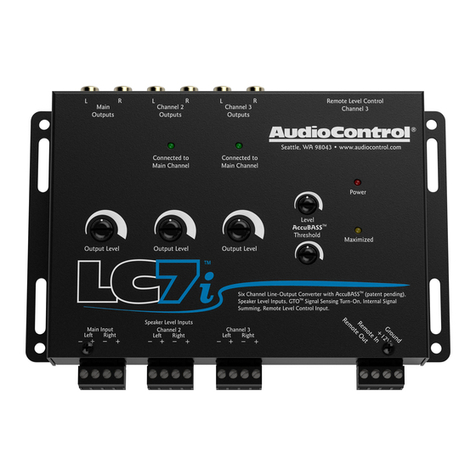
Audio Control
Audio Control LC7i User manual

Audio Control
Audio Control DQ-61 User manual
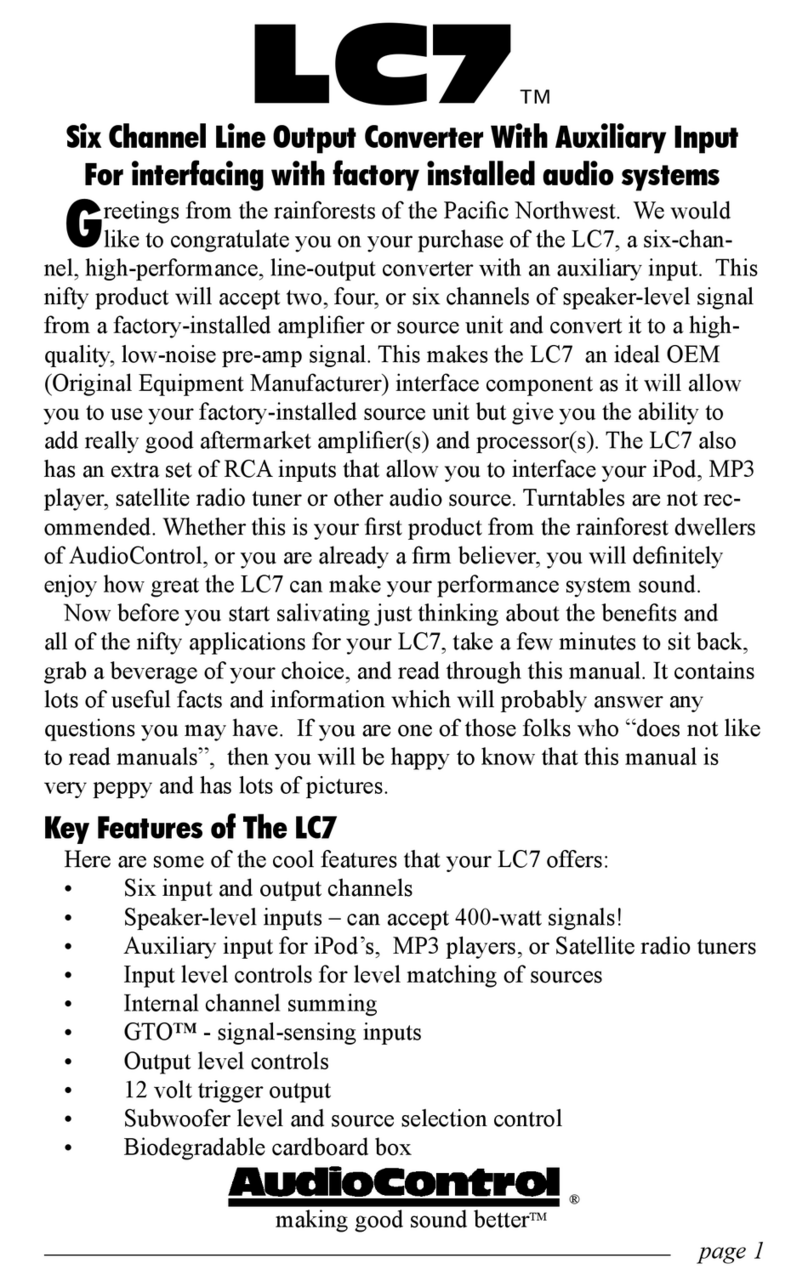
Audio Control
Audio Control LC7 User manual
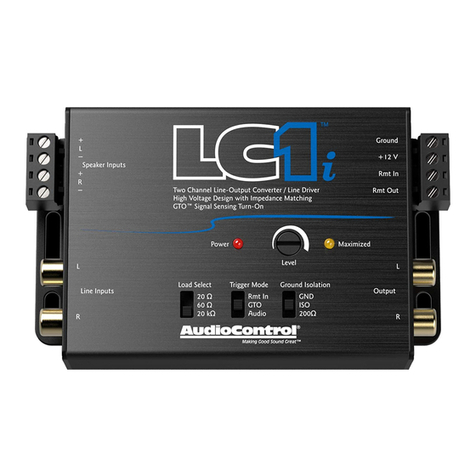
Audio Control
Audio Control LC1i User manual
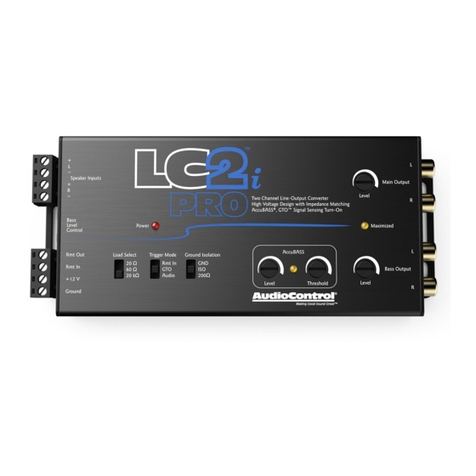
Audio Control
Audio Control LC2i PRO User manual

Audio Control
Audio Control DQ-61 User manual
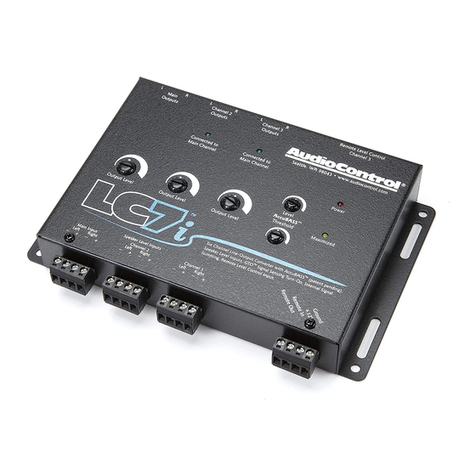
Audio Control
Audio Control LC7i User manual
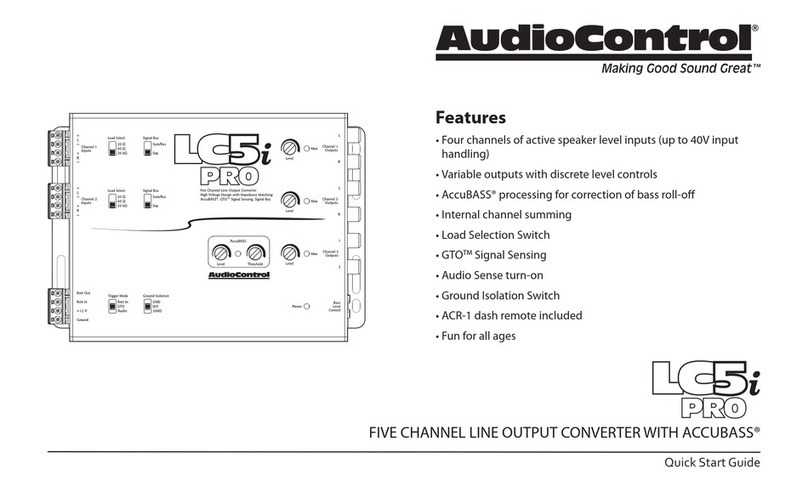
Audio Control
Audio Control LC5i PRO User manual
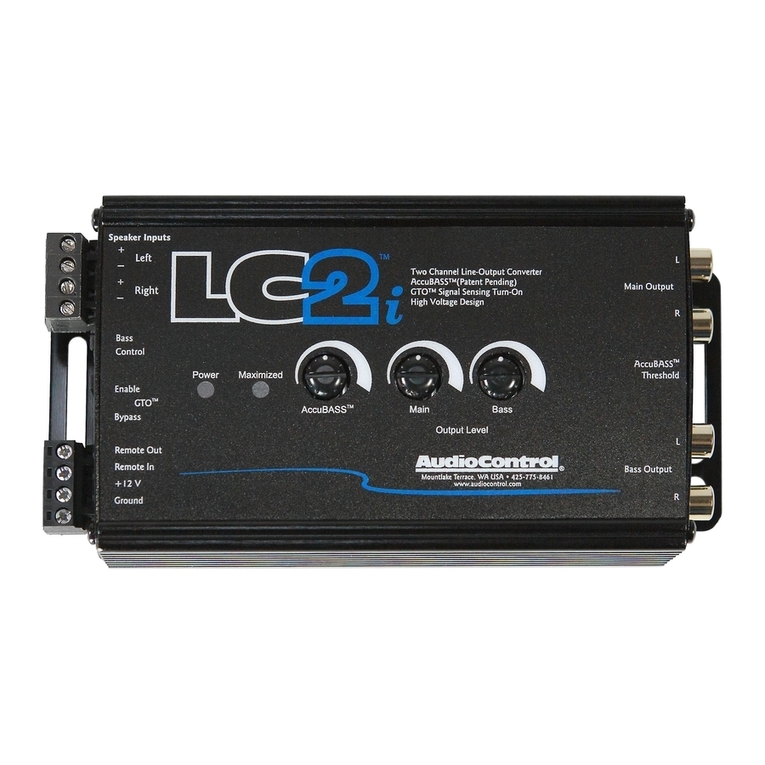
Audio Control
Audio Control LC2i User manual


